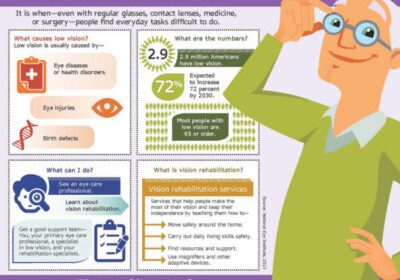
Our awareness feature for February is low vision. Low vision differs from nearsightedness or farsightedness because it can’t be corrected with glasses, surgery, or medicine. Low vision affects your ability to live your life as you’ve always done. It can become difficult to move around your house, read books, cook dinner or drive your car.
Low vision can be caused by eye injuries, diseases, disorders, diabetes, or brain injury. One of the common types of low vision is age-related macular degeneration. Almost half of all cases of low vision are associated with age-related macular degeneration. Your doctor can help determine if you are subject to low vision by reviewing your family history and doing a thorough eye exam including dilating your pupils. Additionally, pay attention to your daily habits. Is it becoming difficult for you to read books/newspapers? Are you having any issues recognizing people by their faces? Is it difficult when you are driving to read the street signs, even with your glasses on? Any of these concerns should be discussed with your doctor.
One help for drivers is the use of bioptic lenses or bioptics. This is a pair of lenses that have telescopes attached to them to improve the distance vision of the person wearing them. The glasses show far objects closer and clearer. For Michigan, as with most other states, the laws related to the use of bioptic lenses for driving have specific vision requirements attached for their use. If the vision criteria are not met, then driving privileges will be affected. Additionally, new users of bioptics may have greater restrictions (loss of night driving privileges) for a period of one year or more. Again, vision restrictions will apply. The users will also need to attend driver training/classes in the beginning and if they want to expand their driving choices.
One of the biggest concerns for drivers is the loss of peripheral vision. As vision begins to fade, the peripheral vision becomes paramount to determining whether an individual can remain safely on the road. Driving privileges can be taken away if it is determined through examination that the peripheral field of vision of the individual is less than 90 degrees. This would mean that when they come to a stop, they might not be able to see oncoming traffic from the left or the right, or might not be able to see someone crossing the street. They could if they turn their head, but then the field of vision in front of them is affected. They would not be able to make a safe assessment as to whether they could enter the intersection safely or not.
Leave a reply →